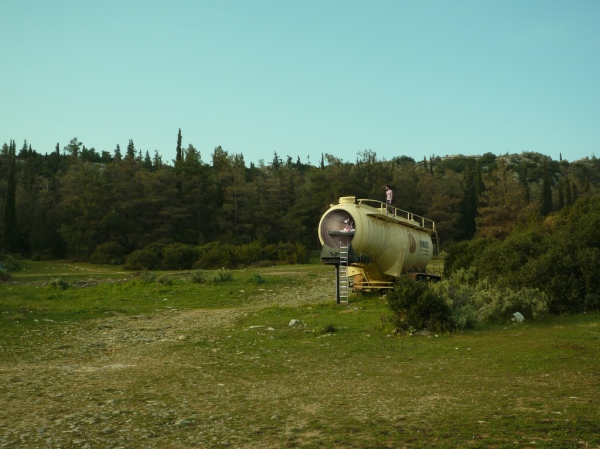KEG apartment | Aristide Antonas

We have always loved architectural speculations, since the utopia’s times in the late 60’s and 70’s with Archigram, Archizoom, Superstudio, Cedric Price and Yona Friedman among many others. During the last twenty years architecture speculations were almost dead, it survived only in students works and not much more; but now, in the last two or three years, with the economical crisis and the construction boom finished, it seems that we’re looking again to think and re-think architecture. And these kind of exercises are a good way to keep ideas alive.
Some studios are designing living sculptures, megastructures and cities that they are not sure if can be constructed, but what are really great news, is that architects are dreaming and playing again.

This is what happens with some of the works of Aristide Antonas, that he calls his “real fake” works and his “stable vehicle” works. This time we’re focusing our attention in the KEG apartments, shelters inside wagons designed by Antonas with the collaboration of Katerina Koutsogianni.
We can read at the design text wrote by Antonas:
An important aspect of what we could name “civilization of today” lies on the possibility of rearrangement of existing things. We detect this civilization of rearrangement when we think about a growing dj culture or the culture of curating. These ‘post production’ instances mark the will to elaborate a plethora of a heterogeneous set of existing elements through a single move of selecting: this selecting act determines the character of each particular choice. These post-production works are analogue to works of a particular collage. We can think about the civilization of today as a multitude of desperate moves to reorder a huge storehouse of juxtaposed elements. This particular rearrangement is in the same time a move that determines unifications of the multiple and in the same time it requires the handling of an existing material in a way that this material gets a new meaning. In this new aesthetics of quantity, the idea of rearrangement can be considered as a type of creation.



Guided by Walter Benjamin’s idea about what an essay could be: a series of fragments: the essayist was called to put in a line those fragments and to take care and handle the junctions between them, Antonas is seeking for interesting re-appropriations that provokes approaches of different elements, transformations of the given. This aesthetic orientation brings a new meaning of simple collage techniques. As he writes, “the existing things are destinated to be the creative material of tomorrow.”
Instead of discard the existing transportation wagons, he thinks about this particular garbage as a system of ‘abandoned spaces’. They form rooms that can still move or can function again as movable. They can be used as holiday rooms or as small office places, if we think of them as places equipped with network collections.
The apartment is described with these words:
The keg apartment is proposed as a program. One can also recognize different strata of architectural solutions in this work. They are grouped here in two versions. The keg wagons can be detached from their cars and can form more stable units for a certain period. A big circular window can be introduced in the vehicle’s cylinder towards the car’s side with the use of an enforced circular frame. This will give the form of a window open to the driver’s section or to any chosen view if the keg stops in a particular way. The circular window can also serve as a projection screen surface if a special tissue is unfolded.



You can see the complete photo-set here and read Antona’s blog here.
About this entry
You’re currently reading “KEG apartment | Aristide Antonas,” an entry on dpr-barcelona
- Published:
- November 15, 2009 / 9:19 pm
- Category:
- Architecture, cities
- Tags:
- Architecture, Aristide Antonas, Projects, Speculatives

28 Comments
Jump to comment form | comment rss [?] | trackback uri [?]